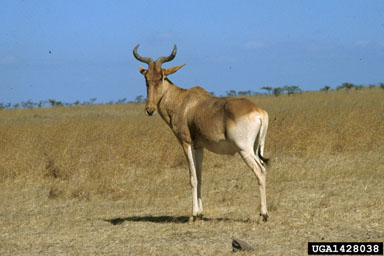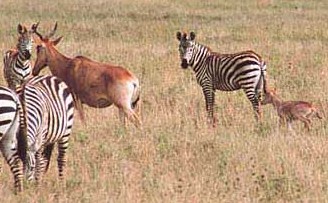Family:
Bovidae
Subfamily:
Alcelaphinae
Genus
Alcelaphus
Hartebeest,
Alcelaphus buselaphus
Bubal Hartebeest, †Alcelaphus
buselaphus buselaphus
Coke's Hartebeest, Alcelaphus buselaphus cokii
Lelwel Hartebeest, Alcelaphus buselaphus lelwel
Western Hartebeest, Alcelaphus buselaphus major
Swayne's Hartebeest, Alcelaphus buselaphus swaynei
Tora Hartebeest, Alcelaphus buselaphus tora
Red Hartebeest, Alcelaphus caama
Lichtenstein's Hartebeest, Alcelaphus lichtensteinii |

http://www.awf.org/wildlives/121
The hartebeest is a large, fawn-colored antelope that at first glance
seems strangely misshapen
and less elegant than other antelopes. Clumsy in appearance, it
is hump-shouldered, with a steeply
sloping back, slim legs and a long, narrow face. It is far from
clumsy, however, and is in fact one of
the fastest antelopes and most enduring runners. These qualities
gave rise to the name "hartebeest,
" which means "tough ox."

©
John H. Fields,
http://www.meandmephoto.com/Africa/Pages/Animals.html
Hartebeests, Alcelaphus buselaphus, are larger antelopes
with sloping backs and high shoulders
with short and glossy coats. They have an elongated muzzle with
horns that are ringed and lyre shaped.
They have preorbital scent glands and hoof glands only in their
forefeet. They are a plains antelope that
also frequents open woodland and tall bush grasslands. They are
found more often in these areas than
Wildebeest and Topi,
other members of its Tribe.
Hartebeests = Bubalis Swaynef ?

Hartebeest,
Alcelaphus buselaphus - overblikk
BBC Natural History Unit
http://www.arkive.org

Hartbebeest
Photographer: William M. Ciesla,
http://www.forestryimages.org/

Hartebeests, Alcelaphus buselophus, are "grazers"
who prefer medium grasslands.
The herd is a female hierarchy. Territorial bulls form bachelor
herds and do not defend all
their territory equally. Calves are "hiders" for about
2 weeks.
©
John H. Fields,
http://www.meandmephoto.com/Africa/Pages/Animals.html

(Tekst basert på Hele verdens dyreliv, bind
6, LibriArte 1996)
(Bilder fra National Geographic, March 1983, er illustrasjonsfoto
tatt i Namibia, Afrika)
Beira, Dorcatragus
megalotis
http://www.ultimateungulate.com/Artiodactyla/Dorcatragus_megalotis.html
|












